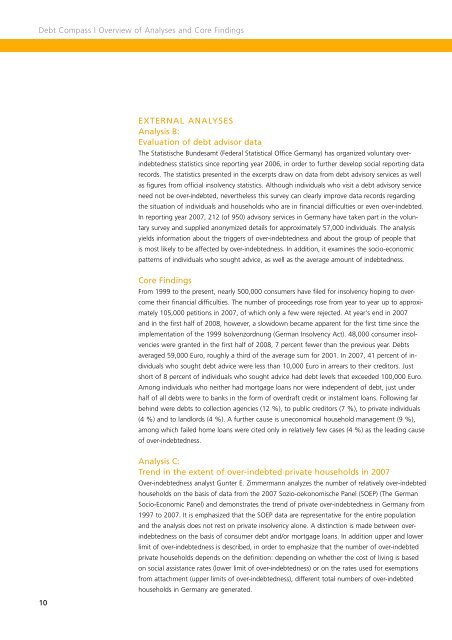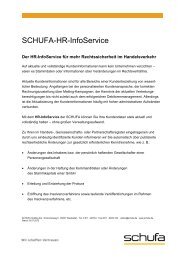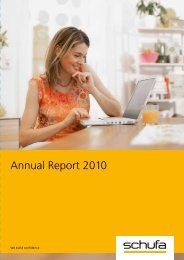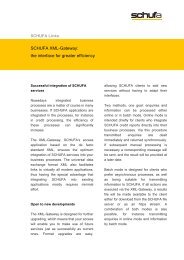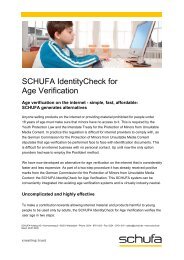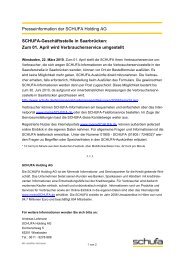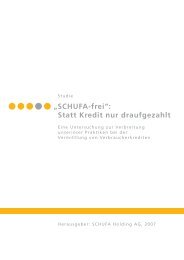Abridged English version of the SCHUFA Credit Compass 2008
Abridged English version of the SCHUFA Credit Compass 2008
Abridged English version of the SCHUFA Credit Compass 2008
Create successful ePaper yourself
Turn your PDF publications into a flip-book with our unique Google optimized e-Paper software.
Debt <strong>Compass</strong> | Overview <strong>of</strong> Analyses and Core Findings<br />
10<br />
EXTERNAL ANALYSES<br />
Analysis B:<br />
Evaluation <strong>of</strong> debt advisor data<br />
The Statistische Bundesamt (Federal Statistical Office Germany) has organized voluntary overindebtedness<br />
statistics since reporting year 2006, in order to fur<strong>the</strong>r develop social reporting data<br />
records. The statistics presented in <strong>the</strong> excerpts draw on data from debt advisory services as well<br />
as figures from <strong>of</strong>ficial insolvency statistics. Although individuals who visit a debt advisory service<br />
need not be over-indebted, never<strong>the</strong>less this survey can clearly improve data records regarding<br />
<strong>the</strong> situation <strong>of</strong> individuals and households who are in financial difficulties or even over-indebted.<br />
In reporting year 2007, 212 (<strong>of</strong> 950) advisory services in Germany have taken part in <strong>the</strong> voluntary<br />
survey and supplied anonymized details for approximately 57,000 individuals. The analysis<br />
yields information about <strong>the</strong> triggers <strong>of</strong> over-indebtedness and about <strong>the</strong> group <strong>of</strong> people that<br />
is most likely to be affected by over-indebtedness. In addition, it examines <strong>the</strong> socio-economic<br />
patterns <strong>of</strong> individuals who sought advice, as well as <strong>the</strong> average amount <strong>of</strong> indebtedness.<br />
Core Findings<br />
From 1999 to <strong>the</strong> present, nearly 500,000 consumers have filed for insolvency hoping to overcome<br />
<strong>the</strong>ir financial difficulties. The number <strong>of</strong> proceedings rose from year to year up to approximately<br />
105,000 petitions in 2007, <strong>of</strong> which only a few were rejected. At year's end in 2007<br />
and in <strong>the</strong> first half <strong>of</strong> <strong>2008</strong>, however, a slowdown became apparent for <strong>the</strong> first time since <strong>the</strong><br />
implementation <strong>of</strong> <strong>the</strong> 1999 Isolvenzordnung (German Insolvency Act). 48,000 consumer insolvencies<br />
were granted in <strong>the</strong> first half <strong>of</strong> <strong>2008</strong>, 7 percent fewer than <strong>the</strong> previous year. Debts<br />
averaged 59,000 Euro, roughly a third <strong>of</strong> <strong>the</strong> average sum for 2001. In 2007, 41 percent <strong>of</strong> individuals<br />
who sought debt advice were less than 10,000 Euro in arrears to <strong>the</strong>ir creditors. Just<br />
short <strong>of</strong> 8 percent <strong>of</strong> individuals who sought advice had debt levels that exceeded 100,000 Euro.<br />
Among individuals who nei<strong>the</strong>r had mortgage loans nor were independent <strong>of</strong> debt, just under<br />
half <strong>of</strong> all debts were to banks in <strong>the</strong> form <strong>of</strong> overdraft credit or instalment loans. Following far<br />
behind were debts to collection agencies (12 %), to public creditors (7 %), to private individuals<br />
(4 %) and to landlords (4 %). A fur<strong>the</strong>r cause is uneconomical household management (9 %),<br />
among which failed home loans were cited only in relatively few cases (4 %) as <strong>the</strong> leading cause<br />
<strong>of</strong> over-indebtedness.<br />
Analysis C:<br />
Trend in <strong>the</strong> extent <strong>of</strong> over-indebted private households in 2007<br />
Over-indebtedness analyst Gunter E. Zimmermann analyzes <strong>the</strong> number <strong>of</strong> relatively over-indebted<br />
households on <strong>the</strong> basis <strong>of</strong> data from <strong>the</strong> 2007 Sozio-oekonomische Panel (SOEP) (The German<br />
Socio-Economic Panel) and demonstrates <strong>the</strong> trend <strong>of</strong> private over-indebtedness in Germany from<br />
1997 to 2007. It is emphasized that <strong>the</strong> SOEP data are representative for <strong>the</strong> entire population<br />
and <strong>the</strong> analysis does not rest on private insolvency alone. A distinction is made between overindebtedness<br />
on <strong>the</strong> basis <strong>of</strong> consumer debt and/or mortgage loans. In addition upper and lower<br />
limit <strong>of</strong> over-indebtedness is described, in order to emphasize that <strong>the</strong> number <strong>of</strong> over-indebted<br />
private households depends on <strong>the</strong> definition: depending on whe<strong>the</strong>r <strong>the</strong> cost <strong>of</strong> living is based<br />
on social assistance rates (lower limit <strong>of</strong> over-indebtedness) or on <strong>the</strong> rates used for exemptions<br />
from attachment (upper limits <strong>of</strong> over-indebtedness), different total numbers <strong>of</strong> over-indebted<br />
households in Germany are generated.


